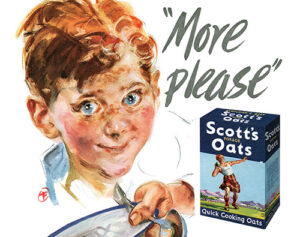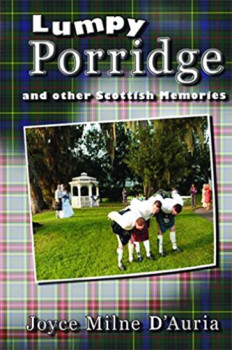
Scottish porridge advertisement from the Scott’s Porage Oats company
Scottish Porridge Advice
I have given this advice before regarding Scottish porridge, but it bears repeating:
Do not eat it with the BIG Scottish breakfast. You’ll hurt yourself. However, a bowl of homemade Porridge, by itself with whatever you decide to enhance it with, does a body good!
Scottish Porridge is a traditional breakfast made from oats. It has several different spellings in Scotland: porage, porrige, and even parritch {which is how Robert Burns spelled it}.
Scottish porridge is usually called oatmeal in the United States –and often treated with suspicion.
Porridge is made by boiling oats and water; traditionally served with a little salt on top and a splash of cream. (However the Milne Family enjoyed it with a spoonful of sugar. This influence crept in, no doubt, from my mother’s English mother.)
Take Yer Lumps
We weren’t morning people at my house in Coatbridge back in the day. More crabbit than chipper before we had our morning cuppa and warmed our rear ends at the kitchen stove.
Our cheerful, busy Mum was the only exception. “Eat yer porridge. It’s good for ye.”
Oh, no, the dreaded lumpy breakfast. We kids preferred toast with cheese or marmalade. We begged for Kellogg’s cornflakes or better yet one of Mum’s big breakfasts.
“Oh, no! Not porridge again.” We four children whispered round the table. We’d have said it out loud, but back then complaining about the haute cuisine got you nowhere but left sitting at the kitchen table until your plate was clean or someone came along and removed your skeleton.
Well, that’s a slight exaggeration but knowwhitahmean?
My mother’s traditional Scottish porridge, God rest her soul, was not her crowning achievement. Lumps! Yes, I’m sorry to say. Big lumps!
Delicious Traditional Scottish Breakfasts
Now I have to rush to her defence. She made the best Ham ’n Eggs in Lanarkshire and I have friends and family who will attest to this. Could she wield an iron frying pan. She’d light the gas cooker with a match, and almost before its violet flame could cheer you, your hungry heart leapt with joy as the lard hit the pan with a satisfying sizzle. From the pantry appeared an overflowing plate of Ayrshire bacon, black pudding, and at least two shapes of sausages—links and sliced. While this mélange was filling the kitchen with an aroma that cannot be adequately described, eggs filched from under our own squawking hens, and potato scones were lined up ready to be added at the moment when enough of the flavoured fat had been rendered in the frying pan. A nice homegrown tomato from my father’s greenhouse would garnish the dish in season.
At the table a pot of fresh tea, some of Aunt Nan’s homemade marmalade, good butter, and a heaping plate of plain bread toasted. Awright!
But porridge, I’m sorry. It was a disaster.
More on my Warning Above
On a recent trip to Scotland, my husband partook generously at each Bed and Breakfast of the big traditional Scottish breakfast AND the porridge. This is not recommended. Take one or t’other. Not both. Though he is not Scottish (Italian) he believes in getting what he paid for even if he has to suffer for it. Suffer he did. Moans and groans and unjustified complaints about good Scottish cuisine and unfair comparisons to the healthy lifestyle of a Mediterranean diet.
But a diet of the delicious fatty food aforementioned leads to some other wee problems. I and my cousins are at an age when we compare cholesterol scores.
Cousin Gordon, from Coatbridge, recently whispered to me his cholesterol level, adding, “The doctor says it’s no’ bad ‘for the region’.”
Oops! “For the region.” What does that mean? Sounds ominous.
Yes, the diet of my youth cannot be the diet of my advancing years. Unfortunately, my regional cholesterol score has carried over into the New World.
Which takes us back to porridge. Robert Burns called parritch, “Chief of Scotia’s Food.” Do you suppose he knew that:
While some people frown at the idea of sugar on porridge, others not only approve but suggest a tot of whisky. Each to their own!
Traditionally, Scots put salt on their porridge. We grew up adding sugar. Probably an English tradition we got from our maternal grandmother from Burnley, England.
In addition to my own memories about Scottish porridge, I did a little research online about it, and while I was online I found a recipe that reminded me of my Grannie’s oatmeal stuffing. A bonus!
OATMEAL STUFFING or SKIRLIE
In a pan melt a good dod o’ butter
Add a chopped onion and about 4 sticks chopped celery cook till slightly softened
Tak’ aboot two haunfu’s of Scottish oatmeal (the good stuff) and stir in.
season to taste salt, pepper, sage (a wee tot of whisky, yes, that’s how it’s spelled)
If you cook this a wee while and serve it, you’ve made Skirlie. Fancy that!
OR pop it now into the turkey or chicken before roasting and wait for the wonderful smell to go floatin’ out on the glen
Porridge has more protein than other cereals; keeps your blood sugar even; is easy on the stomach; reduces your risk of heart disease; increases serotonin (the feel good brain chemical), and reduces your regional cholesterol.
OK, Mum. I’ll eat it.
And I do. No Lipitor for me.
Armed with my spurtle, the obligatory wee stick for stirring the porridge, and a bag of steel-cut Scottish oats, I drag my crabbit self into the kitchen and boil water in my non-stick pot and gradually add the oats and stir.
Forgot to tell you, Mum, Granny showed me how to cook parritch … without lumps. All you have to do is to keep stirring it while it is cooking!
This is one of many stories that come from the book, Lumpy Porridge and other Scottish Memories. To learn more about the book, follow the link!

